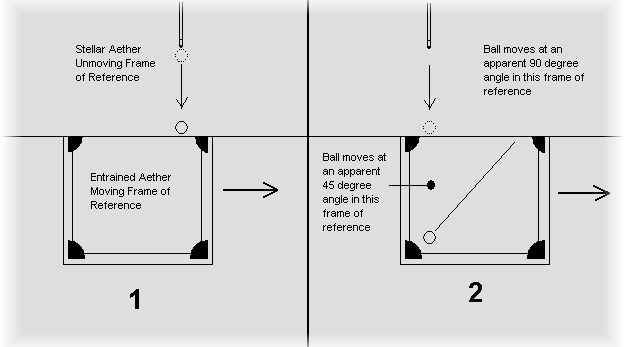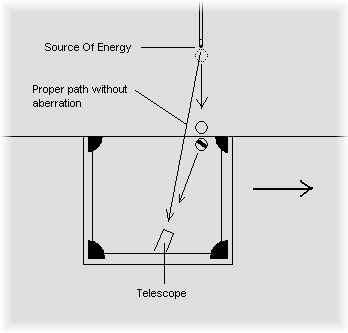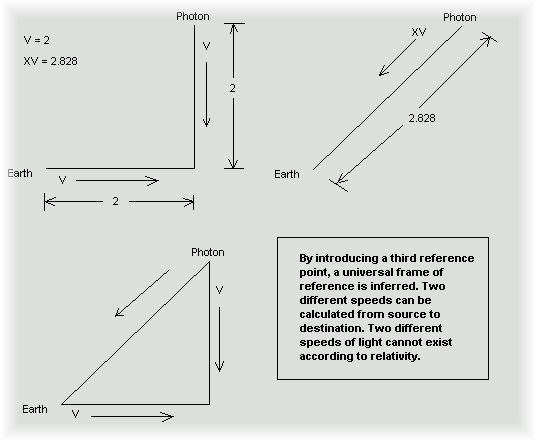Stellar Aberration
Stellar aberration is one of the most well known problems with relativity but as usual, the least understood. I will attempt to explain how this phenomenon is irreconcilable with relativity. Other sources such as Wikipedia can supply the basics to give you a running start. For the sake of brevity I will assume the reader has some basic knowledge of the effect and will try to elaborate.
Stellar aberration is the effect well known by astronomers to cause stars to shift up to 20.5 arc seconds in their location in the sky. The amount of apparent positional change is governed by the time of year and location in the sky with regard to the Earth's orbit around the sun. This number also mathematically correlates perfectly with the earth's speed around the sun compared to the speed of light. So far, all relativists are in agreement with me.
The problem however lies in the human predilection to arbitrarily pick a preferential point of reference. Almost every glossed over flaw in relativity can be attributed to this. Unfortunately, what makes this even more confusing is the fact that it is the overall correct thing to do. I say that there is a preferential frame of reference that can be used and it is called Aether. However, the defenders of relativity are not allowed to use this but when they use their common sense they cannot help themselves. Allow me to demonstrate.
If you understand relativity you should have immediately picked up on the fact that the light between an emitter and an observer should have absolutely no relation with some third object. Yet we find that stellar aberration is perfectly related to a third object: Our speed with respect to the sun. They have picked the sun as the center of a preferential reference frame and have no idea they did it. If you simply pick some other third object as a reference for the Earth's speed you could give the earth any heading and any speed conceivable. If there is no absolute or preferential frame of reference then stellar aberration would be the same regardless what direction and speed the earth moved in regard to the sun. Stellar aberration would not exist as it is observed.
Below I will explain stellar aberration and how it relates with Aether drag or entrainment. Mainstream scientists claim that it disproves the entrainment theories when it in fact neither proves nor disproves drag, but it does prove the existence of Aether. There are problems with the specific embodiment of Stokes' and Fresnel's models of Aether drag but larger areas of entrainment easily overcome the problems associated with those embodiments of the theory.
The largest problem with mainstream understanding of entrainment or drag is the thought that "total entrainment" would result in no stellar aberration, this is very easily refuted.
Aether drag happens on multiple scales, as it would in a fluid and there is very likely some interaction with gravity.Though, the size and intensity of entrainment could very well correlate with the Earth's field of gravity, we will examine drag on a global bubble scale.While I propose that the transition would happen a little at a time instead of at a specific border, we will use a bubble analogy for ease of understanding. On this global scale, the aberration happens at the transition between non-entrained space and entrained space. The light is merely transferred into the entrained "bubble" around the earth which then faithfully carries the modified angle of incidence directly to the observer. This can be visualized by imagining a billiard table cut in half with another gigantic half billiard table the size of a football field that is the same height as the first. These two tables then have their open ends put together and the smaller table is slid along the larger table. See below:


If a ball on the larger table is rolled perpendicular to the edge with the correct timing to hit a ball on the smaller table, the ball on the smaller table will move in a straight line but not strike the rear of the smaller table at the same angle the energy started in according to that frame of reference. To make the ball enter a tube placed at the center of the far end of the small table, the tube would have to tilt forward of the actual point of origin.
Unfortunately for the relativists, their logic won out over their adherence to relativity. Their common sense comes through in their arguments and conflicts with the theory. The very basis of relativity is that light speed never varies in regard to any observer. There is no difference in the relation between the "detector" and the speed of light ever. The relative velocity between the earth and the photons should be exactly C. By trying to make sense of nonsense they always accidentally slip in a preferred frame of reference. They have neglected the fact that by using the sun as a reference point they have opened up the possibility for 2 different interpretations of the speed of light.

The distance traveled by an individual photon can be calculated down one of the legs of the triangle or the hypotenuse. Two different distances in the same time gives two different speeds.
Further speculation on the subject:
[1] H. E. Yves
"Extrapolation from the Michelson-Morley Experiment" J. Opt.
Soc. Am. 40, pp. 185-190 (1950)
Also - P.
Marmet, “The Overlooked Phenomena in the
Michelson-Morley Experiment”
[2] E. Eisner, "Aberration of Light from Binary Stars - a
Paradox?" Am. J. Phys. 35, pp.817-819 (1967)
[3] T. E. Phipps "Relativity and Aberration," Am. J. Phys., 57, pp., 549-550 (1989) also Phipps T. E., Jr., "Stellar Aberration from the standpoint of the Radiation Convection Hypothesis." Phys. Essays 4, 368, (1991
[4] H. C. Hayden, Stellar Aberration," Galilean
Electrodynamics, 4. pp. 89-92 (1993)